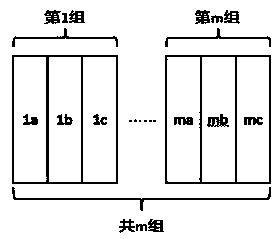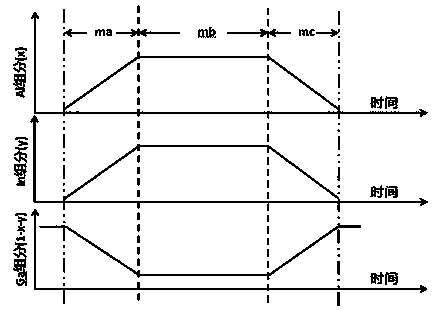Light-emitting diode with novel P-type electron barrier layer structure and growth method
An electron blocking layer, light-emitting diode technology, applied in circuits, electrical components, semiconductor devices, etc., can solve the problems of enhanced vertical confinement, low hole injection efficiency, and reduced number of holes, etc. quality, the effect of reducing dislocation density
- Summary
- Abstract
- Description
- Claims
- Application Information
AI Technical Summary
Problems solved by technology
Method used
Image
Examples
Embodiment 1
[0028] A light-emitting diode with a novel P-type electron blocking layer structure and its growth method, the growth method of its LED epitaxial structure, including the following specific steps:
[0029] Step 1: Clean the substrate 1 at a high temperature for 20 minutes in a nitrogen atmosphere at 1200°C, and then perform nitriding treatment. The substrate 1 is a material suitable for the growth of GaN-based semiconductor epitaxial materials, such as sapphire, GaN and silicon carbide (SiC) monolayers. Crystal, etc.;
[0030] Step 2, lower the temperature to 650°C, grow a low-temperature GaN buffer layer 2 with a thickness of 230nm, control the growth pressure between 300-760 Torr, and set the V / III ratio to 1000;
[0031] Step 3: After the growth of the low-temperature GaN buffer layer 2 is completed, the introduction of trimethylgallium (TMGa) is stopped, the substrate temperature is raised to 1200° C., and the low-temperature GaN buffer layer 2 is subjected to in-situ ther...
Embodiment 2
[0041] A light-emitting diode with a novel P-type electron blocking layer structure and its growth method, the growth method of its LED epitaxial structure, including the following specific steps:
[0042] Step 1: Clean the substrate 1 at a high temperature for 20 minutes in a hydrogen atmosphere at 1000°C, and then perform nitriding treatment. The substrate 1 is a material suitable for the growth of GaN-based semiconductor epitaxial materials, such as sapphire, GaN and silicon carbide (SiC) monolayers. Crystal, etc.;
[0043] Step 2, lower the temperature to 600°C, grow a low-temperature GaN buffer layer 2 with a thickness of 200nm, control the growth pressure between 300-760 Torr, and set the V / III ratio to 1000;
[0044] Step 3: After the growth of the low-temperature GaN buffer layer 2 is completed, the introduction of trimethylgallium (TMGa) is stopped, the substrate temperature is raised to 1000° C., and the low-temperature GaN buffer layer 2 is subjected to in-situ ther...
PUM
 Login to View More
Login to View More Abstract
Description
Claims
Application Information
 Login to View More
Login to View More - R&D
- Intellectual Property
- Life Sciences
- Materials
- Tech Scout
- Unparalleled Data Quality
- Higher Quality Content
- 60% Fewer Hallucinations
Browse by: Latest US Patents, China's latest patents, Technical Efficacy Thesaurus, Application Domain, Technology Topic, Popular Technical Reports.
© 2025 PatSnap. All rights reserved.Legal|Privacy policy|Modern Slavery Act Transparency Statement|Sitemap|About US| Contact US: help@patsnap.com



